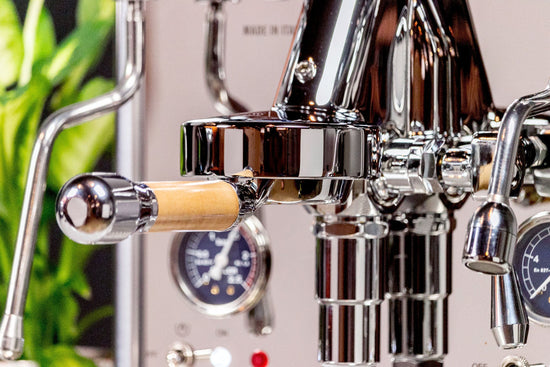What is Pre-Infusion?

After you’ve spent all of 5 minutes in the world of coffee you’ll start to hear a myriad of terms and techniques thrown around. It can feel like you’re learning a new language. One of the first words you’re bound to learn if you’re focused on espresso is “pre-infusion.” So what does it really mean? Watch below to find out.
Full video transcript below:
Pre-infusion refers to the process of gently soaking the puck of ground coffee in your portafilter before applying the full desired brewing pressure. The goal is to ensure that water evenly penetrates the grounds to ensure that the entire bed has the same amount of water flowing through it once extraction begins. In practice, this works quite well. When we’ve tested shots pulled with pre-infusion vs shots pulled without we notice significantly fewer instances of channeling – that’s when water finds a path of low resistance and flows through it, avoiding nearby grounds. This over-extracts that channel and leaves surrounding areas under-extracted.

This benefit is just as handy to new baristas as it is to professionals. If you’re just starting out it helps to have something that evens out any inconsistencies in the distribution of grounds in your portafilter. Even once you’ve spent years as a barista there’s no reason not to employ a technique that helps ensure you get a consistent extraction every time. In fact, many home baristas and shops graduate to more complex forms of pre-infusion.
You’ll find pre-infusion at its simplest in machines with the classic E61 group head design, like our LUCCA M58. By lifting the brew lever part way, the path between the machine’s water inlet and the group head is opened – but the key here is that the pump is not turned on. This allows the passive line pressure of the water line to push water from the boiler to the puck of coffee at the group head. This line pressure is much less than the 9 bars that the pump will apply, evenly and gently saturating the puck. Most baristas will apply pre-infusion for somewhere between 2 and 8 seconds before lifting the lever all the way, engaging the pump.
That method only works for direct plumb machines. Reservoir machines, without the benefit of line pressure, have to use different methods to accomplish pre-infusion. Take, for example, the LUCCA A53 Mini, one of few reservoir machines with pre-infusion. It uses a specially designed chamber with a piston and spring that attaches like a dead-end to the route between the boiler and group head. When you start your shot the path between the boiler and the group head is opened and the pump turns on to begin pushing water. Some of that water will head down the dead end and push against the piston, diverting some of the pump’s pressure away from the puck of coffee. When the pre-infusion timer ends that dead end is sealed off and full pressure is then directed toward the pump. While the method here is quite different, the end result is the same gentle pre-infusion you’d get with a direct plumbed machine, with the added benefit of being able to digitally program the duration.
Beyond pre-infusion lies a world of complexity and experimentation. Things like “flow profiling” or “pressure profiling” can be seen as the next step in the evolution of pre-infusion. We’ll have more on that in a future video.